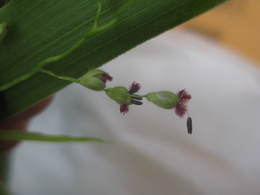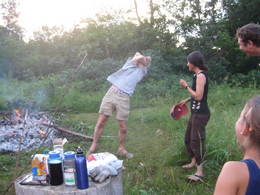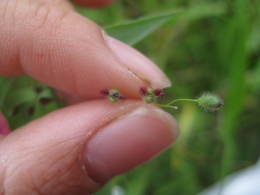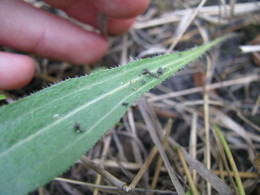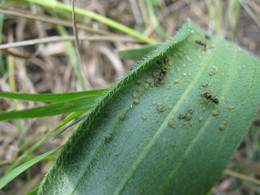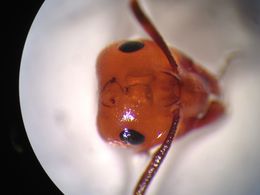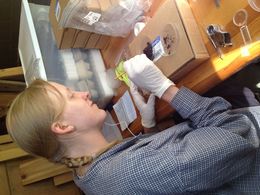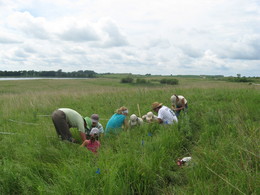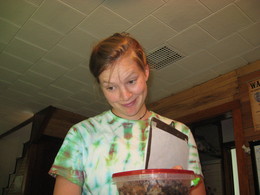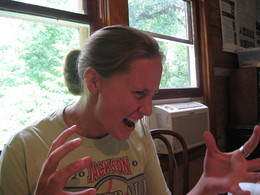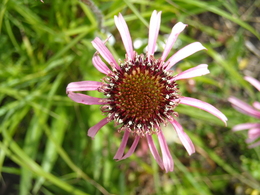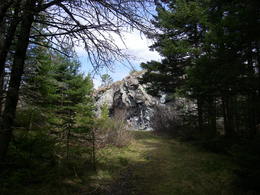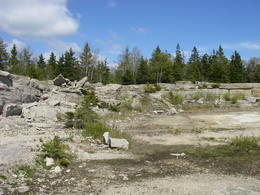|
|
Howdy folks,
Maria reporting from K-town.
Sunday we had a real day off =)
The weather was good and sunny, but not too hot.
Random tidbits from the town hall:
Shona made oatmeal pancakes for breakfast – they were really yummy – thanks Shona!
Kelly and Shona went swimming at Elk Lake and bumped into the Wagenius family
Katherine found a new trail in the forest at the Runestone Park on her biking adventure
Andrew had a great time at home and arrived at the town hall before 11pm
Lydia spent the day helping out in the kitchen at the camp in Alexandria
I made Irish Soda Bread to use up some sour milk, but still have ~1 cup sour milk (turned into buttermilk substitute, any ideas what to do with it? Pancakes would be easiest, but we just had them)
After the weekend break, it’s time for work again! Monday (today) we divided and conquered.
AM – Greg set out his yellow pan traps in his remnants. Stuart, Katherine, Jill, Lydia and I did demo in the remnants. Ruth and Greg came to join us. We found many Echinacea flowering at Loeffler’s Corner East, an okay number at Loeffler’s Corner West, 2 at Railroad Crossing (Douglas County), and ~6 at Yellow Orchid Hill.
The others (Shona, Kelly, Andrew) did CG1 rechecks and then worked on their independent projects.
Ruth bought some delicious fluffy spongy chocolate cake which we cleaned off the dish.
PM – The two teams switched jobs. Stuart led Shona, Kelly, Andrew, Ruth and Greg in demo at KJs and On 27. The rest of us did CG1 rechecks, and then worked on independent projects.
Here’s a file called “Crash Course in R”, which might be helpful to folks
crashR.2.pdf
Now for some photos!
Flowering Dichanthelium!

I think this is a super cool picture as it shows 3 stages of Dichanthelium stigmas/anthers emergence. See how the bottom-most spikelet has the stigma just emerging, while the anthers are still inside; the middle spikelet is open and has both stigma and anthers well-exserted; and the top spikelet is closed and the anthers are drooping out from the spikelet.

Last but not least here’s an epic picture from our bonfire last year 😀

Saturday brought a resurgence of the “not-so-bad” weather we’ve been enjoying this week. Several rainstorms have brought some much needed moisture to the soil. The reason I mention this is that while I worked on my aphid addition/exclusion experiment, I noticed a lot of dirt mounds on plants where aphids were present. Presumably, ants build these structures to cultivate aphids. Some of these were small, consisting of only a few small pieces, and some were large, taking up a large portion of a leaf. Here’s one of the smaller examples. The opposite side of the leaf was covered in aphids.

Here’s a picture of one of the plants in my aphid addition group. As you can see, the ants are taking full advantage of the situation:

As for other field work, Kelly spent the morning checking the status of flowers for her phenology study. Most of the remnants have stopped flowering, with the exception of one plant at a small remnant and many at the Staffanson prairie preserve. Because the west half of Staffanson was burned in May, Echinacea began blooming later than in the unburned half.
In the evening, we all gathered at the Wagenius family home for potluck dinner and bonfire. I should say bonfires, since there were two right next to each other. Pyromanic desires were fulfilled by all.
So what do 696 ants look like?
 Like this. Like this.
I believe these guys are Formica obscuripes. The Formica genus can be identified by the three very distinct ocelli on their foreheads and the short but prominent frontal carinae, the two dark lines extending upward from the bases of the antennae.
 For most of Friday I worked through my pitfall traps, with Katherine diligently sorting through hundreds of ants, grouping them by the most similar-looking. For most of Friday I worked through my pitfall traps, with Katherine diligently sorting through hundreds of ants, grouping them by the most similar-looking.
 We also encountered a few questionable ants which may also be Formica obscuripes, but with highly inflated gasters. We also encountered a few questionable ants which may also be Formica obscuripes, but with highly inflated gasters.

The progress is slow, but steady– by 5pm, we finished 12 of the 144 traps.
Aside from my life in antworld, the other members of Team Echinacea worked on their individual projects and completed a few smaller tasks including:
-GPSing the recruitment plots
-GPSing a few positions in the common garden
-Scanning data sheets for Amy
-Entering data from seedling searches
Overall, Friday was very productive for all of us and we look forward to more days like it this coming week.
Now that Team Echinacea has (finally!) finished measuring plants in CG1, we’ve started a couple of new activities. In the morning a group went into CG1 to place staples at locations where plants have not been found for the past three seasons. These staples help us to keep track of distance between plants when measuring.
In the afternoon, almost everyone went out to the North of Railroad and Railroad sites to work on demography. In brief, demography is a way to keep track of plants in the prairie remnants that Team Echinacea studies by finding and taking the GPS locations of flowering plants every year. By understanding how often plants flower and how often new plants flower for the first time, we can get a better idea of whether or not a population is stable.
As a Flog Post bonus, I’m including some haikus that I wrote yesterday morning when we were trapped indoors by the rain. I’ve written one about each Team Echinacea member’s project this year as well as several more general haikus about what we do. Enjoy!
The Echinacea Project Haikus.doc
As dawn broke on yet another day in Kensingtonville, Team Echinacea arose to a dark sky producing ominous rumbles of thunder. An occasional pitter-patter turned into a steady fall of condensed water vapor. The team members wearily turned to each other and half-heartedly debated whether to arrive at base per normal routine. Some, namely Katherine, Jill, and Greg, decided that it would be best to separate from the rest of the crew for a while and work under the grey skies above. Those who remained in the heart of Kensingtonville hurriedly tried to edit abstracts whilst waiting for the skies to be more favorable. After a few dreary hours, sunrays started to peek through the clouds, and then suddenly burst out with blinding brilliance, stunning those indoors. After the initial shock of seeing sunshine, select members of the crew finished their abstracts and drifted off into the land of unicorns and chocolate chip cookies.
After lunch, the two parts of the crew decided that it would be in our best interest to come back together and work as a brave platoon to conquer the plot that is Caroline’s, over yonder at Hegg Lake. After a few encounters with fierce toothpicks and cardinal directions, Team Echinacea prevailed!! (And finished early. Woohoo!!)

Team Echinacea has taken on another difficult task: the task of mastering the Dread Pirate R. And his crew of R.O.U.S.’s (R-scripts Of Unusual Size). R comes to you at night and steals your sanity. But only part of it. There’s a big difference. The crew has differing opinions about R:
Those who don’t mind it too much:

And those who mind it quite a bit:

On the brighter side of the spectrum, the crew finished the day early, and therefore had more time to lounge around/nap/work on projects. A few decided to go for a swim in the great Elk Lake before dinner (which was quite nice, if I might say so myself).
Tuesday morning marked the end of measuring in the common garden!!!! It was slightly anticlimactic with only one and a half rows left to finish but it is still rewarding to be finished.
It was a rainy morning so we didn’t get out to the common garden until about 10:30, but we had time to pull all of the thistles between measuring and lunch. Now there will be one less prickly plant to avoid when we return to recheck missing plants and contradictory records in the next few weeks.
While the rest of us were working inside or in the common garden Katherine and Jill spent a long morning at work in the remnants performing their aphid and any survey. They made significant progress, leaving only two small sites to finish on wednesday, and found Kelly’s sunglasses that she had lost at Staffanson.
We had been planning to spend the afternoon measuring in the common garden, but since we finished earlier than expected we had the rest of the day to work on individual projects. Many of us took the opportunity to prepare abstracts for submission to the University of Minnesota for the poster session we will be presenting at on August 9th. It turns out that abstracts become more challenging to write when you are still floundering through R endeavoring to analyse your results, but as Stuart reminded us, all (or most) of the other presenters are likely to be facing the same challenges.
I haven’t been very good about taking photos recently, but while I’m on the topic of individual projects here are two photos that relate to my work. The first one is E. angustifolia and the second is E. pallida. You can see how they have a slightly different appearance.


This week started off strong with a morning of dedicated work on independent projects; Jill and Katherine visited a couple of remnants to work on the ant and aphid surveys, Maria continued her observations at Hegg lake, and the rest of us enjoyed the cool of the Hjelm house as we put or noses to the grindstone, analyzing our data and beginning to work on our posters. To help us prepare for writing our abstracts, before lunch Stuart gave a quick tutorial on putting hypotheses into words, a task that some of us found surprisingly challenging. After lunch Jennifer Ison gave a presentation which she had prepared for the recent evolution meeting, and we finished off the day by measuring the last major set of rows in the big batch garden. Now only 1 and 1/2 rows left.. Woohoo!
 Jill is busy looking for those ants and aphids. Jill is busy looking for those ants and aphids.
Lydia mapped many Echinacea plants in two remnants: eelr and alf. Here is a list of distances in meters between all pairs of plants.
distancesForLydia.RData
This version of Lydia’s R script will read her dataset and edit it and then read the distances and merge them to her compatibility dataset.
mergeScriptForLydia.R
Sunday was a much-anticipated day off for all of us in K-town. Kelly’s grandparents were in town, Lydia was off working at Mount Carmel, and Andrew spent time with his girlfriend, Kelsey, showing her around the research sites. Meanwhile, I slept in and made “bark stuff” (an addicting chocolaty dessert) to satisfy my weeklong chocolate craving. I also GRE-ed, made a concerted effort to learn more Italian verbs, and worked on some things for my research back in Maine. Although I don’t have any pictures from the day, I do have some pictures of my research sites in Maine for those who haven’t seen a heaping hunk of serpentine before. The top picture is Pine Hill, a serpentine outcrop, and the picture below it is Settlement Quarry, a granite outcrop.
 
Now that the vast majority of Echinacea are finished flowering (except for the populations at Staffanson and one lonely plant at Northwest of Landfill), I’ve started piecing together a master datasheet with the first and last day of flowering for every Echinacea head that I have been studying. Please let me know if you have any comments or recommendations for statistical analysis, possible comparisons to other data sets, or better organizational methods!
phen_mastersheet_2012.csv
phen_mastersheet_2012_metadata.doc
|
|
